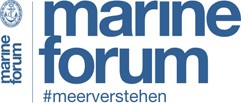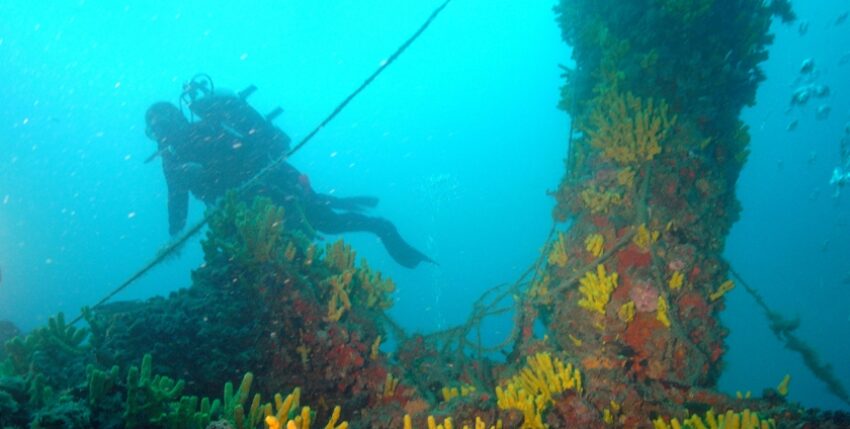Thousands of military wrecks with remnants of ammunition on board lie at the bottom of our seas. Each one has its own special features, as an exciting example from the Adriatic shows.
The Adriatic - a fascinating holiday destination on the Mediterranean. Every travel guide extols the turquoise waters, unspoilt landscapes, historic towns and first-class Mediterranean cuisine. But this idyll is deceptive, as a look underwater reveals.
It is the beginning of 1944 and the Second World War is entering its decisive phase. Victory for Germany and its allies is becoming increasingly unlikely. Although Goebbels had already proclaimed "total war" in February 1943, the Allies were advancing on all fronts. The German Reich had hardly any reserves left. On the eastern front the Wehrmacht was pushed back. In the west, British and American aeroplanes bombed the major cities. After the German and Italian African troops had surrendered, the Allies increasingly gained the upper hand in the entire Mediterranean region. This also made it increasingly difficult for German troops to resupply across the Adriatic Sea. The increased use of Allied fighter-bombers from Italy and the growing presence of the British navy also increased losses there.
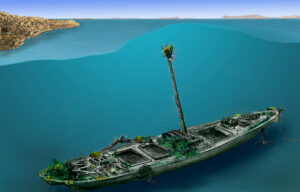
Time bomb in the Adriatic Sea, photo: Leidl/Najada d.o.o.
Under the title "Flag 4", the flag signal for opening fire or launching torpedoes, the British author Dudley Pope describes the activities and battles of the British speedboat flotillas in the Mediterranean during the Second World War in his book. Based on British sources and contemporary witnesses, the book also includes a detailed account of the battle and sinking of a German ammunition transporter off the Croatian coastal town of Šibenik.
This is a three-masted motor-sail cargo ship with 281 gross register tonnes, which was built in Flume, now Rijeka, in 1942 and christened "Francesca da Rimini" by its Italian owner Rodolfo Gattoni. The name refers to an Italian noblewoman who became famous in the 13th century when she was murdered by her husband, Giovanni Malatesta, for adultery with his younger stepbrother Paolo. It is not known whether the owner deliberately chose this circumstance for the name. At the beginning of the Second World War, the cargo ship was taken over by the Italian military to transport weapons across the Mediterranean. In 1943, after Italy's capitulation, the German navy requisitioned the 42 metre long and 12 metre wide steel ship. It was mainly used for supply voyages along the Adriatic coast, but these ended abruptly.
320 tonnes of ammunition
In order to be able to act quickly and surprisingly, the British coastal forces deployed different types of speedboats. Ships of the Fairmile D type with longer hulls, more powerful engines and heavier armament were increasingly used in the Adriatic. This version was more seaworthy and better able to counter the threat posed by German warships. Pope reports on the deployment of two of these speedboats, the motor gunboat (MGB 662) under the command of T/Lt. Timothy James Bligh, and the motor torpedo boat (MTB 649) under the command of T/Lt. Peter Hughes, whose account is reproduced here in abbreviated free form:
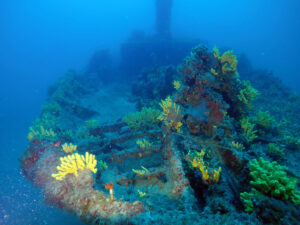
It is 2 February 1944 at around 17:00 - MGB 662 and MTB 649 leave the port of Komiža on the Croatian island of Vis for a patrol in a northerly direction.
19:15 - Shortly before Šibenik, MGB 662 stops a small boat. Three fishermen are taken on board for questioning. They claim to be partisan sympathisers and claim that there are no German ships in the area.
21:30 - MGB 662 spots a three-masted enemy motor glider heading south-east at about eight knots. MGB 662 and MTB 649 give chase and close to within 140 metres. The motor glider fires a white flare. Both sides open fire with their on-board cannons. The enemy is hit along the hull and deck, catches fire and there are explosions. Some of the crew jump overboard. Twelve survivors are rescued from the water by the British.
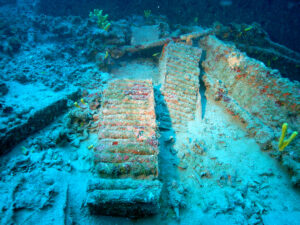
22:15 - After further explosions, the burning motorised glider sinks into the waters of the Šibenik archipelago. MGB 662 and MTB 649 resume their patrol and return to the base in Komiža late in the dense fog. During the subsequent interrogation of the prisoners, it turns out that the ship was the Francesca da Rimini. On her last voyage, she had loaded 320 tonnes of ammunition - mainly for 105 mm guns - 10 tonnes of supplies, 15 tonnes of blankets, a lorry and a motorbike. On board were twenty-five German soldiers as passengers, all of whom apparently perished, as well as a crew of nine Italians and five German gunners. MGB 662 was slightly damaged by 20 mm bullets, MTB 649 remained undamaged.
Occasionally, another version of the sinking is briefly described in the literature. According to this version, the Francesca da Rimini was anchored with engine damage on 27 March 1944. At around 15:00, British aeroplanes attacked by dropping aerial torpedoes and sank the ship. Despite an intensive search, no verifiable evidence for this version could be found. The only reference to the date given in the specialised literature for the area near Šibenik is that several pioneer landing craft were damaged or sunk there by British fighter-bomber attacks.
Dive into the depths
The Francesca da Rimini is still very well preserved today. Although the upright wreck is relatively close to the north coast of the island of Kaprije, a dive there is very challenging. It can only be reached via an open water descent. The stern, the shallowest part of the ship's hull, can only be reached at a depth of 38 metres. At the bottom of the bow, the deepest point of the ship, the water depth is 52 metres. Over the decades, a wide variety of marine life has colonised the wreck. The many large yellow sponges are particularly impressive. Of the three masts, only one still rises upright, the other two are broken at the base.
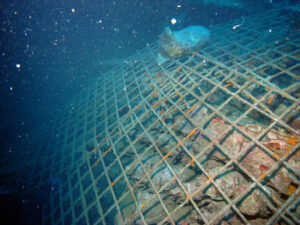
105-millimetre bullets, photo: Nehring archive
The four-barrelled anti-aircraft gun is still clearly visible in the centre of the stern. Stacks of anti-aircraft ammunition are lying around openly, and there are also other ordnance in transport crates or scattered openly on deck and to the right and left of the wreck. Hundreds of primed 105 mm shells and other military equipment are still stored in the two large cargo holds. In the area of the aft hold, a large outwardly pressed damage to the ship's hull can be seen on the starboard side, which was most likely caused by an explosion inside the hold.
Ticking time bomb
Many of the wrecks at the bottom of our seas date back to the world wars and were lost as a result of acts of war or were later deliberately sunk. They often still have ammunition, warfare agents and other environmental toxins on board. Salvaging these hazardous goods is usually difficult and cost-intensive. But what is the right way to deal with these ticking time bombs?
A large part of the 320 tonnes of ammunition loaded at the time is still on board the Francesca da Rimini today. Nevertheless, the wreck can be dived at any time by diving schools with the appropriate licence from the Croatian Ministry of Culture. For safety reasons, the responsible authorities covered at least the ammunition in the holds with steel grids, which are also weighted down with boulders, over 20 years ago. However, a glance into the cargo holds is enough to realise that this was only inadequately implemented and that many of the 105 mm shells are still freely accessible.
This lax handling of the existing explosive cargo is surprising. Fortunately, nothing has happened to date. But live ammunition is becoming increasingly unsafe and dangerous due to long-term exposure to salt water. This not only increases the dangers for divers, but also for the entire shipping industry and tourism in the area. In addition, more and more highly toxic substances will be released into the environment in the foreseeable future as the shell casings corrode. The current results from the European "North Sea Wrecks" project show what effects this can have on the marine environment. In the vicinity of munitions wrecks, the researchers discovered fish with a conspicuous number of tumours. It was also shown that mussels and fish accumulate carcinogenic substances such as the explosive TNT. For the researchers, this is a warning sign that marine biodiversity will be increasingly jeopardised by old munitions in the long term.
There is no doubt that the underwater time bombs are ticking. What solutions are available in the case of the Francesca da Rimini should be discussed by carrying out a detailed risk analysis. As a precautionary measure to protect people and the environment, salvaging the cargo would certainly be the best option.
Dr Stefan Nehring is an independent environmental consultant and expert on subaqueous contaminated sites.
Stefan Nehring
